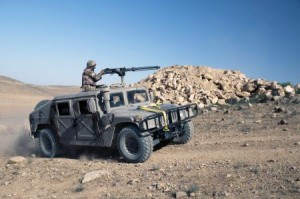 The United States military has secretly sent a task force of more than 150 planners and other specialists to Jordan to help the armed forces there handle a flood of Syrian refugees, prepare for the possibility that Syria will lose control of its chemical weapons and be positioned should the turmoil in Syria expand into a wider conflict.
The United States military has secretly sent a task force of more than 150 planners and other specialists to Jordan to help the armed forces there handle a flood of Syrian refugees, prepare for the possibility that Syria will lose control of its chemical weapons and be positioned should the turmoil in Syria expand into a wider conflict.
The task force, which has been led by a senior American officer, is based at a Jordanian military training center built into an old rock quarry north of Amman. It is now largely focused on helping Jordanians handle the estimated 180,000 Syrian refugees who have crossed the border and are severely straining the country’s resources.
American officials familiar with the operation said the mission also includes drawing up plans to try to insulate Jordan, an important American ally in the region, from the upheaval in Syria and to avoid the kind of clashes now occurring along the border of Syria and Turkey.
The officials said the idea of establishing a buffer zone between Syria and Jordan — which would be enforced by Jordanian forces on the Syrian side of the border and supported politically and perhaps logistically by the United States — had been discussed. But at this point the buffer is only a contingency.
The Obama administration has declined to intervene in the Syrian conflict beyond providing communications equipment and other nonlethal assistance to the rebels opposing the government of President Bashar al-Assad. But the outpost near Amman could play a broader role should American policy change. It is less than 35 miles from the Syrian border and is the closest American military presence to the conflict.
Officials from the Pentagon and Central Command, which oversees American military operations in the Middle East, declined to comment on the task force or its mission. A spokesman for the Jordanian Embassy in Washington would also not comment on Tuesday.
As the crisis in Syria has deepened, there has been mounting concern in Washington that the violence could spread through the region. Over the past week, Syria and Turkey have exchanged artillery and mortar fire across Syria’s northern border, which has been a crossing point for rebel fighters. In western Syria, intense fighting recently broke out in villages near the border crossing that leads to the Bekaa Valley in Lebanon. To the east, the Syrian government has lost control of some border crossings, including the one near Al Qaim in Iraq.
Jordan has also been touched by the fighting. Recent skirmishes have broken out between the Syrian military and Jordanians guarding the country’s northern border, where many families have ties to Syria. In August, a 4-year-old girl in a Jordanian border town was injured when a Syrian shell struck her house, and there are concerns in Jordan that a sharp upsurge in the fighting in Syria might lead to an even greater influx of refugees.
Jordan, which was one of the first Arab countries to call for Mr. Assad’s resignation, has become increasingly concerned that Islamic militants coming to join the fight in Syria could cross the porous border between the two countries.
The American mission in Jordan quietly began this summer. In May, the United States organized a major training exercise, which was dubbed Eager Lion. About 12,000 troops from 19 countries, including Special Forces troops, participated in the exercise.
After it ended, the small American contingent stayed on and the task force was established at a Jordanian training center north of Amman. It includes communications specialists, logistics experts, planners, trainers and headquarters staff members, American officials said. An official from the State Department’s Bureau of Population, Refugee Affairs and Migration is also assigned to the task force.
“We have been working closely with our Jordanian partners on a variety of issues related to Syria for some time now,” said George Little, the Pentagon press secretary, who added that a specific concern was the security of Syria’s stockpiles of chemical and biological weapons. “As we’ve said before, we have been planning for various contingencies, both unilaterally and with our regional partners.”
Defense Secretary Leon E. Panetta met in Amman in August with King Abdullah II of Jordan and at that time pledged continuing American help with the flow of Syrian refugees. Mr. Panetta was followed in September by Gen. James N. Mattis, the head of Central Command, who met with senior Jordanian officials in Amman.
Members of the American task force are spending the bulk of their time working with the Jordanian military on logistics — figuring out how to deploy tons of food, water and latrines to the border, for example, and training the Jordanian military to handle the refugees. A month ago, as many as 3,000 a day were coming over the border. But as the Syrian army has consolidated its position in southern Syria, the number of refugees has declined to several hundred a day.
According to the United Nations, Jordan is currently hosting around 100,000 Syrians who have either registered or are awaiting registration. American officials say the total number may be almost twice that.
The American military is also sending medical kits to the border and has provided gravel to help keep down the dust at the Zaatari refugee camp, which the task force helped set up and is now home to 35,000 Syrians. It has also provided four large prefabricated buildings to be used at Zaatari as schools. One official estimated the cost so far at less than $1 million.
NY Times
Leave a Reply
You must be logged in to post a comment.